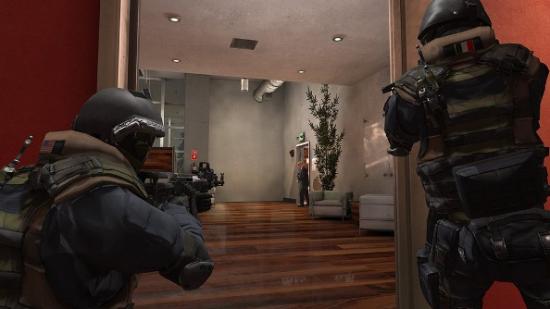Christian Allen has done some very bad things in his career. He has taken hostages and barricaded himself inside buildings. He’s been a burglar, hunted by police. He has been deranged and distraught, attempting to commit “suicide-by-cop”. He has shot and killed law enforcement officers. He’s particularly proud of that part.
“I was like a crazy guy who had taken his staff sergeant hostage, and I had my service Beretta,” he told me over a cigarette at E3. “I climbed up in the ceiling and punched out the ceiling panels. The team flash-banged through the window and then came in through the door, and as they were coming in they were all stacked up and I just opened up.”
Then the rest of them lit up his hiding place with a fusillade of submachine gun fire, and Allen was killed. At least according to the referee for this military police training exercise. Allen was a military policeman with the Marine Corps, role-playing as opposition for the military police equivalent to SWAT teams. Usually this meant being killed or apprehended by a team of seasoned professionals, but this time he’d gotten the drop on the tactical team and the ref ruled that he’d killed the first troopers through the door when he opened up from above and behind them.
It was a huge victory for Allen, and perhaps a fitting one for a military policeman who would end up as a shooter designer. People forget to look up, and he made them pay the price. It gets you killed during a training session, and it will get you killed in Allen’s upcoming tactical FPS, the Unreal powered Takedown: Red Sabre.
Changing the game
Victories like that weren’t easy to come by after Allen left the military and started getting into multiplayer shooters.
“My one buddy, Ryan, he was just a Gauss gun whore, and he would just nail me all the time in Quake. Just constant, boom, dead dead dead. I’d get so mad. And then we played Rainbow 6,” Allen said with a smile. “I remember thinking, ‘Here’s a game I can be good at! Here’s a game – I know about guns, I know how to move, I know how to think, to cover angles, and I can consistently play well.’”
He didn’t know it at the time, but he’d just found his new career. Allen ended up working for Red Storm Entertainment, the studio behind Rainbow Six. Since then he has worked on a number of Ghost Recon games and was lead designer on Halo: Reach.
But while it was a successful career, it was also frustrating. The ruthlessly demanding tactical shooters that brought him into the industry have all but vanished, even at Red Storm.
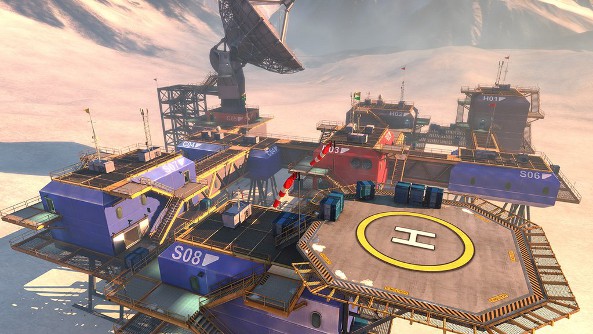
“We kind of strayed away from that on Ghost Recon 2. Ghost Recon: Advanced Warfighter went in a whole other direction,” he admitted. “It’s interesting when you look at a lot of other franchises, like SOCOM. They had the same evolution that Ghost Recon had as the publisher realized, ‘Hey, maybe we’re limited on our audience here. Maybe we need to go broader.’ They lost that hardcore feel.”
Allen founded Serellan LLC in 2011 so he could find that spirit again. They had a successful Kickstarter that raised over $220,000 for Takedown, a deliberate throwback to heyday of tactical shooters, when the SWAT series was still alive and Red Storm’s Rainbow Six and Ghost Recon games were still committed to realism.
Many of the members of Serellan’s roughly ten-person team worked on those games, and then went on work on more mainstream titles. They were brought together by a shared love of this genre that had launched their careers, and a growing frustration with shooter development in the post-Modern Warfare era. They created a prototype that they were able to show publishers and, with the successful Kickstarter to prove there was a passionate audience for a game like this, they were able to find a home with 505 Games.
Still, Allen is taking nothing for granted. He was guarded when I asked about pricing and expansion plans, saying that he hoped they’d be able to keep working on Takedown after shipping but he didn’t want to jinx it.
“It’s not an exact science. It could be that there’s only 5,423 people in the world that really want this game, and every single one of ‘em gave to our Kickstarter,” he admitted, “But people keep hearing about the game. Our community keeps growing.”
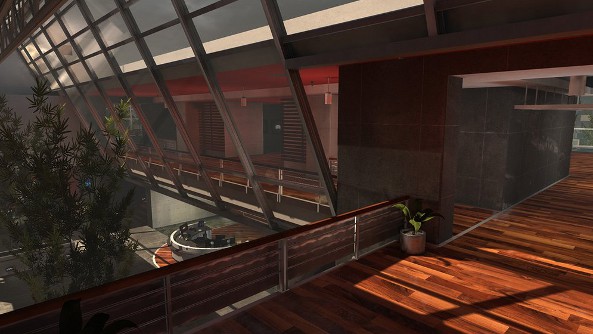
If I were a betting man, I’d wager that more than a few thousand people will enjoy Takedown. I only had a chance to play one co-op mission and observe another, but each contained some of the best parts of Ghost Recon and Rainbow Six while supported by excellent level design and a striking, clean presentation.
There isn’t really a story to Takedown, although producer James Mayo told me that attentive players will be able to discern threads linking the 6-person co-op missions together. You are part of an unethical private military contractor’s elite strike team, Red Sabre, deployed to handle everything from hostage rescue to corporate terrorism.
The first mission I saw involved a decapitation strike against a lavish corporate HQ, a sprawling office campus of glass and steel atriums, high-security server farms, and odd, ultra-modern office clusters. If you’ve ever wondered what a full-on war between tech companies would look like, it’d probably be something like this.
A group of three developers were playing the mission, trying to clear all the security forces from the building while destroying valuable equipment and information. They moved with painstaking care from the first. They would stack up outside rooms before tossing flash-bang grenades through, then follow behind the smoke and noise to take out stunned security officers. Communication was constant, with the point-man calling targets and orienting players around easily recognizable landmarks.
The maps I saw were filled with enough distinct locations and character that players were able to coordinate just by looking at their surroundings. The space didn’t look like it was cobbled together from other game assets and simply given a fresh layout. The entire thing felt like a unique, expensive corporate showpiece.
The map is not the territory
It’s a particular point of pride at Serellan. Allen told me, “We actually build levels backwards from every other game I’ve worked on. Mark Nicolino, one of our lead environment artists, he’s got an architectural background. Deane McGahan, the other environment artist, I’m not sure she has an architectural background, but she built this Headquarters map, which sure feels like it.”
At the start of a level’s life, Allen simply sets some loose parameters. For the HQ, he wanted a large central structure surrounded by open ground and a few outbuildings that players could enter. But what he had in mind was the kind of hacienda where you might find a leader of a drug cartel.
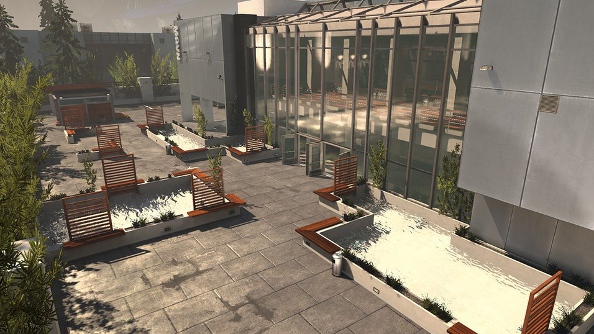
“A hacienda with palm trees, a big wall. And Deane was like, ‘No, that’s shit. I’m doing something different,’” Allen laughed, remembering it. “So she went out and found the architectural style for that building. It’s actually based on a new modern embassy they built in Brussels. She blocked that out.”
After the initial blocking, Allen and the team look at it and consider how it will play. They don’t want any impregnable positions or super-confusing floor plans to bring the game to a halt. Then they populate it with characters to get a sense for the flow of the map and how the action will play out. After incorporating what they learn there, they begin building the level in earnest.
Only after they have a space and an idea of how combat might work there do they set to designing missions. “We’ve got this space. What kind of scenarios make the most sense?” Allen said. “What does it feel like compared to the other missions? Now how am I going to populate it with enemies to optimize the defense of the space?” Allen thought for a second. “Not too optimized. Obviously there’s gameplay in there, so you can’t just have the AI murder you.”
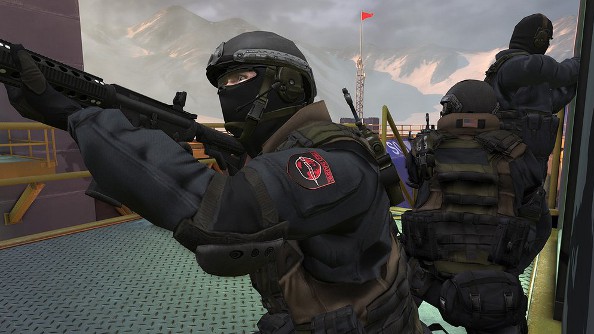
All of which means that Takedown’s levels don’t just feel like paintball arenas wearing the skin of another structure. They are complicated and demanding tactical spaces, harder to read but more satisfying as well. It also means there’s usually several different ways of approaching it. In fact, sometimes the best thing to do is beat a retreat against determined opposition and and going in search of a different route.
That open level design makes for a spine-tinglingly intense experience. I finally got to take part in a mission at an Arctic communications station, an oil-rig like installation with tons of heavy concrete shelters, helicopter landing pads, and, perhaps inevitably, cargo containers and crates. But the sense of exposure and vulnerability was never-ending. We would catch sight of an enemy darting into a housing unit, then realize he could have gone almost anywhere after that. Just moving from a helicopter landing pad to a research center a hundred yards away took ten minutes of slow, methodical teamwork.
The gunfights can be long and intense, with bullets ripping through cover to kill targets, explosives hurtling across no-man’s land, and heavy suppression fire sweeping from side to side. But far more often, they are short, eerily quiet bursts of violence. Someone calls out a target, “Guards coming out on the stairs by N02,” and suddenly everyone drops into cover, taking aim. Then there’s a sudden series of rifles popping and cracking, oddly weak-sounding in the open air, some distant return fire, and then everything is silent again except for people checking in.
While I only saw co-op, there is also 6-on-6 multiplayer. For now, there’s a bomb-defusing mode that’s straight out of Counter-Strike in which one team defends an explosive while the other tries to disarm it. Where it differs, of course, is in its pacing and the fact that the levels are less built around chokepoints.
Goodbye, brown and gray
Something else I enjoyed was how clean and colorful most levels seemed. You might be able to argue it makes spotting enemies too easy, although I still found that tricky at long range, but it also means silhouettes don’t just fade into noisy textures and busy environments. It’s something I brought up with Allen, and he explained it comes out of the team’s fatigue with mainstream shooter levels, and their own limited resources.
Takedown’s first level was a high-tech biological research lab, full of glass, steel, and expensive new lab equipment. Once it was done, they all decided they loved the look. “We kind of latched onto that, because we do think it can be a differentiator,” Allen said. “Let’s have it be vibrant and pretty and nice, and not be grungy and dirty. It’s like a joke amongst us, ‘OK, are we going to do our abandoned warehouse level now? Ok, let’s do your rotting shipyard in Russia! Let’s do our abandoned fishing village in Colombia!”
Clean, new, and modern environments are what give Takedown its distinctive look, but it flies in the face of the “gritty realism” that characterizes most other shooters.
“It’s funny, one of the fans was looking at screenshots.,” Allen said. “He was like, ‘That oil rig looks too clean!’ And it’s like, one, it’s not an oil rig. Here’s some reference of it. And yes, it is clean! In the Arctic, things don’t degrade and wear out. They’re frozen. And he was like, ‘Oh wow, sometimes real life doesn’t look realistic.’”
I didn’t go in expecting a lot from Takedown, but everything I saw looked good. It’s not as complicated as an Arma, but it has a realism and tension that have been missing from most shooters since the early days of Red Storm. It’s probably not going to convert any Battlefield and Call of Duty fans, but for those of us who have spent years missing that pie-slicing, one-shot, one-kill ethos, Takedown looks like it has all the angles covered.
